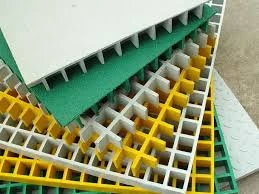loading...
- No. 9, Xingyuan South Street, Dongwaihuan Road, Zaoqiang County, Hengshui, Hebei, China
- admin@zjcomposites.com
- +86 15097380338
- Welcome to visit our website!
fiberglass reinforced plastic grating
Exploring Fiberglass Reinforced Plastic Grating Benefits and Applications
In the realm of engineering and construction, material selection is a pivotal factor that can greatly influence the durability, safety, and cost-effectiveness of a project. One such innovative material that has gained significant traction in recent years is fiberglass reinforced plastic (FRP) grating. Known for its impressive strength-to-weight ratio, corrosion resistance, and versatility, FRP grating is increasingly becoming the material of choice for various applications across multiple industries.
What is Fiberglass Reinforced Plastic Grating?
Fiberglass reinforced plastic grating is a composite material made from reinforcing fiberglass strands embedded in a polymer matrix. This combination yields a highly durable and lightweight material that can withstand extreme environmental conditions. The manufacturing process typically involves the pultrusion method, where fibers are pulled through a resin bath and formed into various shapes, including panels and grids.
Key Benefits of FRP Grating
1. Corrosion Resistance One of the most celebrated features of FRP grating is its inherent resistance to corrosive environments. Unlike traditional materials such as steel or wood, which can deteriorate over time due to exposure to chemicals, moisture, and UV light, FRP grating maintains its structural integrity, making it an ideal choice for chemical plants, water treatment facilities, and marine applications.
2. Lightweight and Easy to Install FRP grating is significantly lighter than steel, facilitating easier handling and installation. This characteristic not only reduces labor costs but also minimizes structural support requirements, allowing designers to create more innovative layouts without compromising safety or stability.
3. Non-Conductive and Non-Magnetic In environments where electrical safety and magnetic interference are concerns, FRP grating serves as a perfect solution. Its non-conductive nature makes it suitable for electrical applications, while its non-magnetic properties make it useful in areas such as clean rooms or MRI facilities.
4. Durability and Low Maintenance FRP grating exhibits exceptional durability, resisting wear and tear from foot traffic, impacts, and environmental stressors. Additionally, it requires minimal maintenance compared to traditional materials. The absence of rust, rot, or splinters results in lower lifecycle costs and extended service life.
fiberglass reinforced plastic grating

5. Customization and Versatility FRP grating can be produced in a variety of colors, shapes, and sizes, allowing for seamless integration into any aesthetic or functional design. This versatility extends to various surface finishes, including slip-resistant options for enhanced safety in high-traffic areas.
Applications of FRP Grating
FRP grating is increasingly being adopted across different industries due to its unique properties. Here are some key applications
- Chemical and Petrochemical Industries Due to its corrosion resistance, FRP grating is ideal for platforms, walkways, and staircases in facilities that handle volatile substances. - Water and Wastewater Treatment FRP grating is used in tank covers, platforms, and screens, where moisture exposure is constant and chemical resistance is essential.
- Marine and Coastal Applications In docks, piers, and marinas, FRP grating enables safe walking surfaces while resisting saltwater corrosion.
- Food Processing and Pharmaceutical Industries Its non-porous nature and ease of cleaning make FRP grating suitable for environments requiring high hygiene standards.
Conclusion
In summary, fiberglass reinforced plastic grating stands out as a versatile, durable, and innovative solution for a myriad of applications across various sectors. Its numerous benefits, including corrosion resistance, lightweight properties, non-conductivity, and customization options, make it an attractive choice for engineers, architects, and facility managers alike. As industries continue to seek reliable materials that enhance safety and sustainability, FRP grating is poised to play a crucial role in the future of construction and industrial design. By embracing this advanced material, organizations can not only meet their operational needs but also contribute to improved environmental responsibility.
-
The Rise of FRP Profiles: Strong, Lightweight, and Built to LastNewsJul.14,2025
-
SMC Panel Tanks: A Modern Water Storage Solution for All EnvironmentsNewsJul.14,2025
-
GRP Grating: A Modern Solution for Safe and Durable Access SystemsNewsJul.14,2025
-
Galvanized Steel Water Tanks: Durable, Reliable, and Ready for UseNewsJul.14,2025
-
FRP Mini Mesh Grating: The Safer, Smarter Flooring SolutionNewsJul.14,2025
-
Exploring FRP Vessels: Durable Solutions for Modern Fluid HandlingNewsJul.14,2025
-
GRP Structures: The Future of Lightweight, High-Performance EngineeringNewsJun.20,2025
